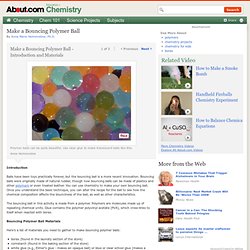

Donald Sadoway: The missing link to renewable energy. The Periodic Table of Oxidation States. Click to enlarge There are a whole host of periodic tables out there, and I’ve already added to the pile with a periodic table of data previously.

Today’s post is another variation on the theme: a periodic table showing the possible and common oxidation states of every element. I was looking for one of these last week, out of interest, and couldn’t find one that presented the information in an easy-to-comprehend manner. To try to solve that, I made the table you can see at the top of the post here. For non-chemists, it’s probably worth clarifying exactly what we mean by ‘oxidation state’. An atom of an element in a compound will have a positive oxidation state if it has had electrons removed. If your only experience of chemistry is from back in school, you might remember the concept of ions – atoms that have gained or lost electrons to form positively or negatively charged ions. Oxidation state 0 occurs for all elements – it is simply the element in its elemental form. Like this: Electrochemistry. Chemistry 1401: Electrochemistry. Instructions Before viewing an episode, download and print the note-taking guides, worksheets, and lab data sheets for that episode, keeping the printed sheets in order by page number.

During the lesson, watch and listen for instructions to take notes, pause the video, complete an assignment, and record lab data. See your classroom teacher for specific instructions. Note Taking Guide Electrochemistry Lab Redox Reactions Lab – Datasheet Need Help? GBP Education offers this video to Georgia Educators at no charge via the GPB Streaming site (Here). Redox Reactions: Crash Course Chemistry #10.
Electrochemistry: Crash Course Chemistry #36. HSC: Chemistry. Could not load plugins: File not found HSC 2015: First in Course Chemistry Joshua Fridgant, First in Course in HSC Chemistry 2014, gives his tips for doing well in your HSC.

The key words found in each question are the essential element to unlocking all HSC science exams. The first thing you should do, before putting pen to paper, is identify the key words and what the question requires. The content, design and structure of your answers should be guided by what each key word requires you to do, such as 'outline', 'contrast' or 'describe'. Using the language of Chemistry appropriately in all responses demonstrates a more thorough understanding. In each exam the extended response questions enable you to demonstrate your wide knowledge of the course and to draw on and explain concepts across the Prescribed Focus Areas and the Domain of the syllabus. Knowledge of first hand investigations in is essential as is the ability to describe a procedure, interpret data and communicate results.
Galvaniccelltypes124CH2012 - home. Make a Bouncing Polymer Ball - Experiment with Polymers. Introduction Balls have been toys practically forever, but the bouncing ball is a more recent innovation.

Bouncing balls were originally made of natural rubber, though now bouncing balls can be made of plastics and other polymers or even treated leather. You can use chemistry to make your own bouncing ball. Once you understand the basic technique, you can alter the recipe for the ball to see how the chemical composition affects the bounciness of the ball, as well as other characteristics. The bouncing ball in this activity is made from a polymer. Bouncing Polymer Ball Materials Here's a list of materials you need to gather to make bouncing polymer balls: Let's make bouncing polymers balls...
Polymer Projects Make Gelatin PlasticMake Plastic from MilkSlime RecipesMake Plastic Sulfur Plastics and Polymers Plastics and Polymers Science ProjectsExamples of PolymersWhat Is Plastic? Lesson_028_handout. Heating Plastics. Lists of Nobel Prizes and Laureates Plastics Play the Heating Plastics Game About the game There are two major groups of plastics - some melt when heated and others don't.

Read More » The Nobel Prize The 1963 Nobel Prize in Chemistry was awarded for the discovery of a catalyst making it possible to produce superior plastics. Read More Plastics and Polymers » Share this: Share on facebook Share on google_plusone_share Share on twitter More Sharing Services3 Share on email To cite this pageMLA style: "Heating Plastics". Recommended: The Legacy of Alfred Nobel On 27 November 1895 Alfred Nobel signed his last will in Paris. Play the Blood Typing Game Try to save some patients and learn about human blood types! Unlocking the Secrets of Our Cells Discover the 2012 awarded research on stem cells and cell signalling. Contact E-mail us Press Sitemap A-Z Index Frequently Asked Questions Terms.
How It's Made: Beer.